Welcome to the in-between.
Want a peek at all my old apartments?
As always, check out the audio version of this post to hear me read this essay, and talk in more detail about this week’s essay subject. And a reminder for paid subscribers that my January 2024’s Month in The Life content is currently live.
I think a lot about before-and-after photos. Home improvement before-and-afters, to be specific. You know the kinds of images I mean, right? They’re the ones you see documented on 30-minute, family-friendly shows on HGTV, the ones where everyone seems to have a budget of $5 million and an incredibly helpful Uncle Jeb or James or Johnny who happens to be a retired contractor looking for a project, or a master woodworker who really just enjoys making people custom cabinets that would otherwise cost $30k. They’re the kind of photos that you’re bombarded with on Instagram, always paired with inspiring music and time lapse videos of people in overalls and paint-splattered smiles high-fiving each other. It’s the kind of stuff that makes you show up at Lowe’s one Saturday morning with nothing but a hope and a prayer, suddenly convinced you can retile a bathroom on your own or re-landscape your entire yard in a weekend.
If you know me, you know I love all of this. Big time. I like to cheer people on when they find their perfect home, and I like even more to scream at them from my couch when they turn an old home into a gleaming, gray-toned open floor plan. All of these before-and-after moments are also at least part of why Jake and I thought that we could buy a 160-year-old fixer upper (though I should mention that the definition of ‘fixer upper’ is, of course, relative) with zero previous renovation experience. It’s also why the very second I walked through the ancient, creaking front doors of our first home, I took a look around, put my hands on my hips, and then pretty much immediately started filming it all. I was excited and proud, sure, but I was mostly intent on getting the ‘befores,’ already imagining the ‘after.’
I should mention that I know not everyone is as interested in home renovation content as I am, so perhaps not everyone walks into a space and is already dressing it up in their head. But speaking personally, I don’t think I’ve ever lived in a place and not had an entire plan for how it should look, going all the way back to my first freshman dorm (shoutout to my Garden State poster) or my childhood bedroom or my college apartment, my bedroom walls decorated with my collection of statement necklaces. In every adult apartment I had before buying this home, I promised myself (and often Instagram) that I would film a home tour, or post about one on my blog. And then I’d put it off again and again, often until I was moving into another space, already dreaming about how that one would be so much better, so much more likely to become an ‘after.’
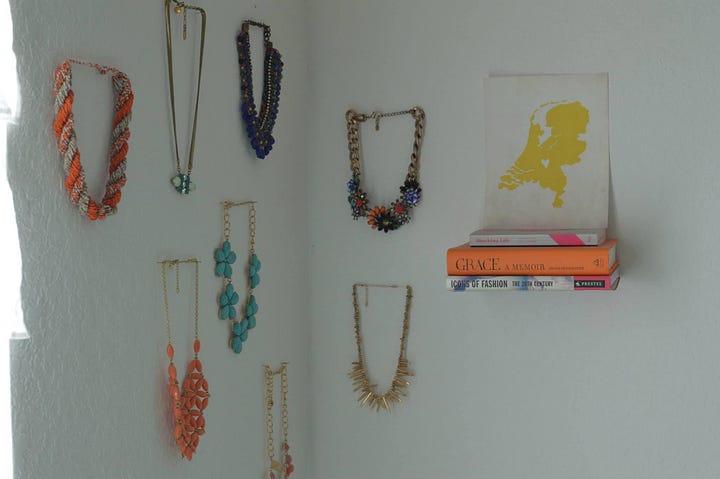
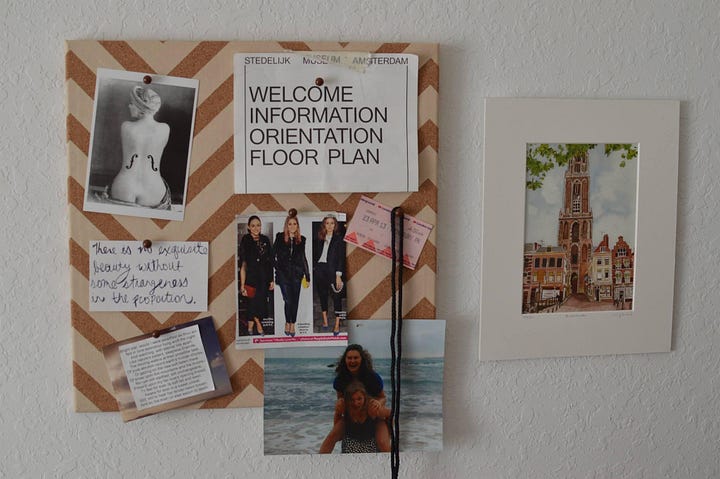





It’s for this reason I don’t have as many photos of my first, ultra tiny apartment as I’d like. I have many tiny snapshots of the space, to be clear (see above). A shot of the miniscule Christmas tree (Christmas shrub?) I ordered on Seamless, the only thing that could (barely) fit in the apartment. The IKEA bed that took up 25% of the square footage of the studio. The bathroom where I kept every single free beauty product I could get from my work, all of it still so new and exciting and (most importantly) free. But what all of these images have in common is that they’re all finely, specifically cropped. I never showed the whole space of anything. I can’t remember now what imperfect background details I was trying to keep out of the shot, but whatever it was, I clearly thought it wasn’t worthy of being documented. Everything was work-in-progress, a thing that was waiting to become better.

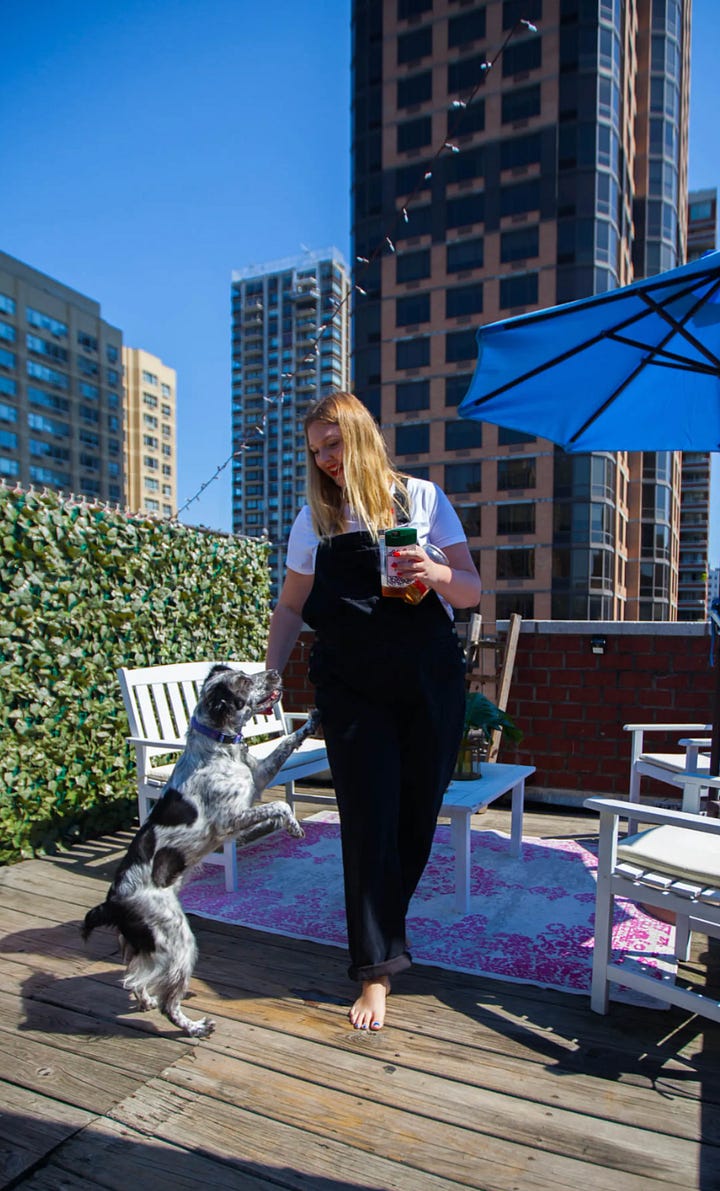
When Jake and I bought this house, and all our old house dreams came true, I was convinced I would finally be churning out before-and-after content on a weekly basis. Here was the ultimate opportunity to get it right. Everything felt like a blank slate, and I felt so compelled to make the changes I dreamt about. There wasn’t a single space that was exactly how I wanted it to be, and that was thrilling. Every single room was a blank canvas, and my imagination swirled with colors and patterns and ideas constantly. I felt inspired in a way I never really had before, or on a grander scale at least, and I was thrilled. Now, here’s where I could tell you all the things I’ve said before about our first year here, our first set of renovations — that it was hard and so much more overwhelming than I could have prepared for. It’s all true, but I also think that when I’ve said that in the past, and sometimes when I say it now, there’s this unsaid second part. Yes, it’s hard, but it will be worth it. One day, it will be worth it. I’m still waiting. Still hyperaware that I’m hanging out in the in between, everything suspended in mid-air, mid-progress. And yet I wonder why I felt unsettled for so long here.
I’ve written before about how this is pretty much exactly how I’ve approached how I feel about any aspect of myself throughout my life. My body. My career. My time management skills. My exercise routine. At different points in my life, almost everything about myself has orbited around the idea of becoming better. Radical self-acceptance was great, only as long as I remembered that it was just temporary. A way of surviving the not-yet-good-enough version of things, of myself. And why value yourself if you know that this is only the half-way version? The half-good version. The in-progress, in-between version. Think about it: How could you ever love or know yourself all that well if that’s how you see things? I’m sure there’s some argument that believing you’re always half-way there means you’re constantly working, constantly trying to improve, but god. How exhausting. Never being satisfied doesn’t sound motivational to me, it sounds sad.
In the moments of the last year when I deeply, painfully missed the more comfortable and familiar version of my life, I wrestled with the thing that everyone says about old houses: It would never be done. All those images I had in my head of perfect rooms would never exist. What have we done? I thought. And then something clicked in my brain: I realized I was right. All those images in my head would never exist. None of it would ever be done. Of course it wouldn’t. Because that’s life. The in between, the progress, the work. That’s life. The adventure of it, the terror of it, the joy of it. It all stems from the fact that we’re in the thick of it, along for the ride. There is no pausing and admiring the after. I’m glad there’s not.
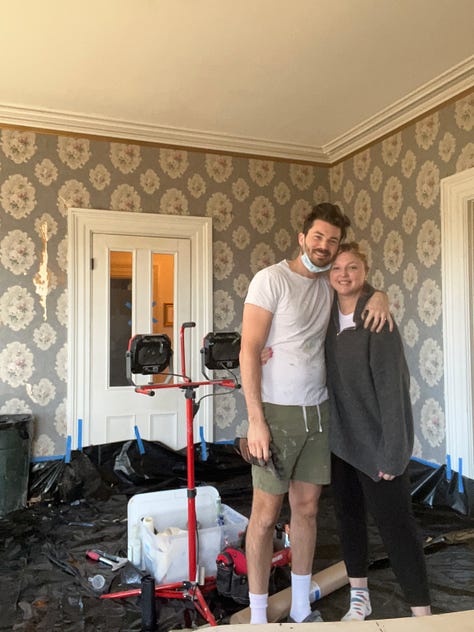
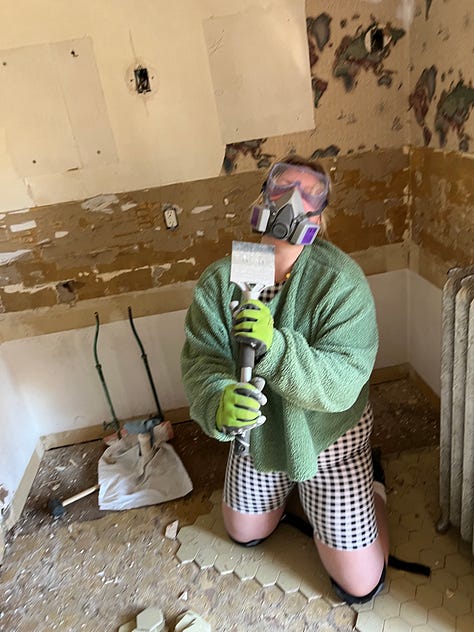
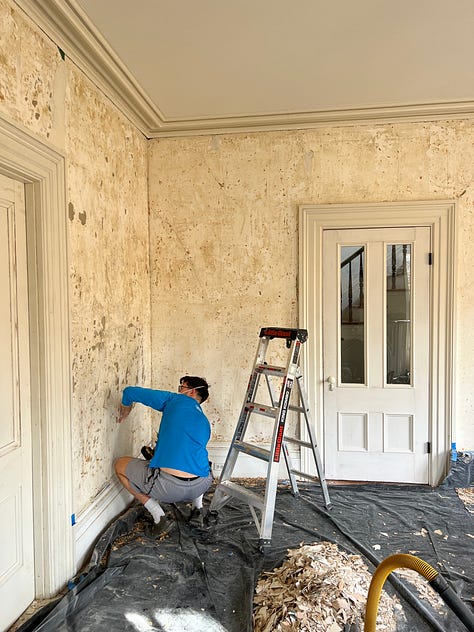
But I do want to make more room for the pausing this year. I want to make more time for the admiration of the in-between, rather than the resentment of it. As I write this essay, Jake is downstairs drilling dozens and dozens of holes into the living room wall, prep for repairing the large cracks in the plaster walls. This week, it’s the living room that’s in a state of chaos, the floors covered in a Dexter-like tarp, and the Dexter-like tarp covered in a million shreds of ancient wallpaper. In a few weeks, it’ll be another room, probably. Another set of cracks. At the beginning of living here, the idea of a never-ending project felt exciting to me. The house would be a life-long creative endeavor, a hobby. As months went on, and life happened, I began to feel overwhelmed by this, agonizing over the fact that it would never look exactly how I had envisioned it in my mind, panicked at that lack of control. Now, I find myself somewhere in between. Yes, the house will be a life-long creative project, an endeavor, a pain in the ass some days and my greatest hobby others. It will also probably never be done. But what is?
What I’m leaning into this year is that the house teaches me something every day. The process of bringing it back to its former glory and at the same time making every space feels like ours is a little bit like being taught a lesson again and again. Every time I try to impose my idea of perfection and timing on the house, it laughs at me a little, I think. Hasn’t she learned by now? I imagine it, or maybe its various ghosts, saying. Hasn’t she understood that she’s not in charge of any of this? It’s an image that always makes me smile, and then reminds me that it’s the truth. We’re not in control of any of it as much as we like to think. And the truth that I’ve started to realize this year is that I don’t really want the after as much as I think I do. I don’t want to sit back and kick up my feet, be done with it all. And I don’t want to be sitting in the in between unhappy, either. I want to relax into it, enjoy it, see it what it really is. Life. Memories in real time. The good old days. Whatever you want to call it, the fact remains that the in between is it. The in between is life. And it’s hard and messy, but god, it’s good, too, isn’t it? It’s so good if we just let it be.

A portion of February’s subscriber proceeds will go toward Save the Children to support its work in providing essential services and support to children affected by violence in Israel and Gaza.



Per usual, this was so well said and written, Olivia!
On a somewhat related note: I'm a big woman. I spent most of my life working myself to the bone trying to remedy that. I found out a few years ago that chronic illness and hypothyroidism (and the inability to tolerate medication for it) will never allow me the body I thought would make me happy. After some serious mourning, instead of focusing on what I thought I should look like, I focused on loving myself as I am, beyond the form I reside in, to be *able* to begin to accept it. Several within-a-50-to-75-pound-range weight-swings later, I'm 40 pounds down from my heaviest weight, realizing I'm just as content now as I was when I was 60 pounds lighter than this—where I naturally look and feel my best for the frame I have. But, what was even more exciting is that I was just as content with the way I look, how I feel, and who I am when I was at my heaviest.
I truly love myself now, and I've never been happier. The 30-pounds lighter was just a "bonus" for my connective tissue disorder's sake.
I recently reconnected with a friend who, for the past decade, has complained about their weight, and our conversations always circle back around to how much they're still busting butt to lose it. Like me, we both bore three children, and our bodies were forever changed, widened, and stretched by that. I don't know if she needed it, but I reassured her of how beautiful, smart, and "valuable" she is no matter what body she's rocking while on the phone yesterday. She thanked me, but immediately continued on about how she's down 20 pounds and how she still has a lot to go.
I asked her, "So, what's next when you reach your goal weight?"
She was quiet.
I wasn't trying to be rude, but I shared that, from experience, I've found that any time I have a goal or idea of how something (or myself) is *supposed* to look or be, when it's reached, I have a fleeting moment of celebration and pride, but a deep feeling of emptiness lurks right around the corner. And *that* is what lingers.
The goal had become my identity. And once reached, what's left? What's worth fighting as hard for?
Each goal needs to one-up the last.
What kind of existence is that?
Your house may never be the exact vision you saw for it initially, but damn is the journey amazing. And it's going to look great, house your family, and it'll be your home.
It'll be as fulfilling as my journey to loving and accepting myself as I am is, no matter what size pants I'm in. That was the *actual* outcome I wanted from the (unrealistic) goal I had in mind. Only now, I could achieve it without the added heartache of disappointment over something that could never be. Just as your house will be something you enjoy when you're "done," just as you embraced and found joy in the renovation process.
It's not giving up. It's realizing that our or societal expectations are often unhealthy for us. Life *is* a journey. Might as well enjoy it, being as healthy as we can be for what we have to work with, and finding contentment and pride in the work we put in over the outcome, even.
Because a goal or vision met is an end. And, if that's all we focused on or cared about, then, what's next?
Wow, I think I have said this already on another post of yours but I love this so much. I even teared up a little bit at the end. How wonderful to be learning this lesson so early on in life. Some people don’t learn it until the end. I’m a few years (maybe a decade?) ahead of you and sometimes I find myself being hard on myself that it’s taken me so long to really understand all those things I’d heard people say all along (“life is about the journey”; “you have to love yourself as you are” — those old cliches that happen to be true but don’t fully make sense until they really make sense). But then I remember: how lucky I am that I learned now and not in another 37 years.
I loved this part: “Radical self-acceptance was great, only as long as I remembered that it was just temporary. A way of surviving the not-yet-good-enough version of things, of myself.” — it’s so easy to get wrapped up in loving yourself so long as you’re doing x, y, z things that you “should” be doing to become “better”. But can you love yourself either way?
And also this: “It would never be done. All those images I had in my head of perfect rooms would never exist. What have we done? I thought. And then something clicked in my brain: I realized I was right. All those images in my head would never exist. None of it would ever be done. Of course it wouldn’t. Because that’s life. The in between, the progress, the work. That’s life.” — This, I think, is the secret. How beautiful a life it is to be spending it alongside your partner, making this beautiful home. It’s not about finishing the home it’s about MAKING it. Imagine 50 years from now the stories you’ll tell and the life you’ll have lived.